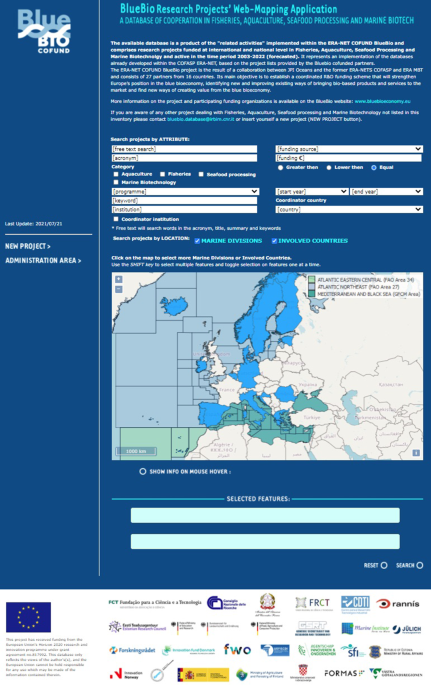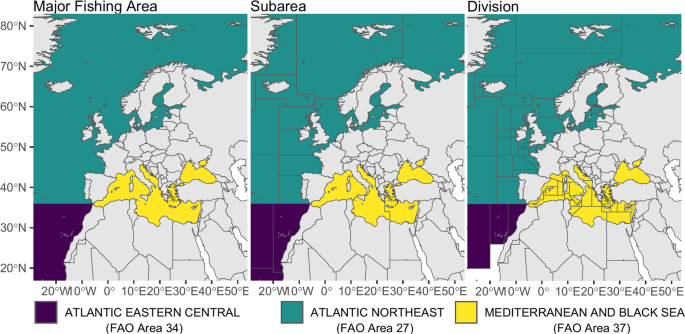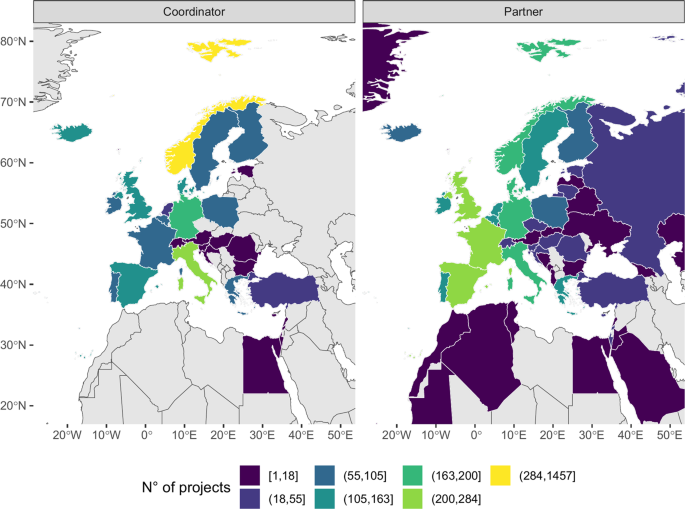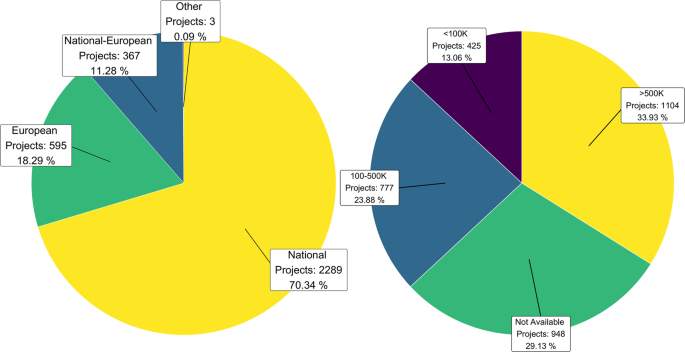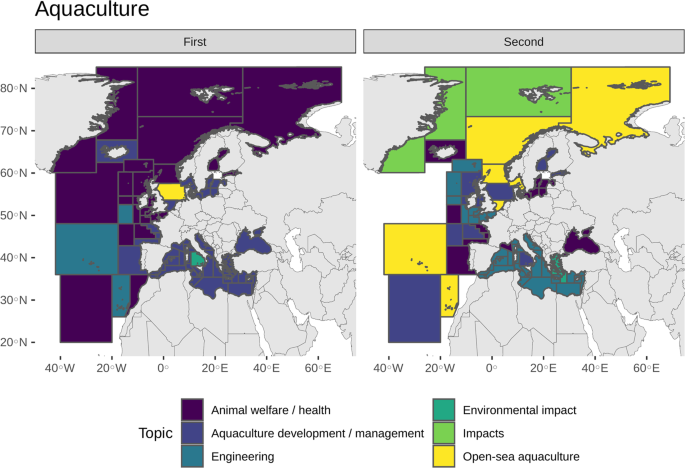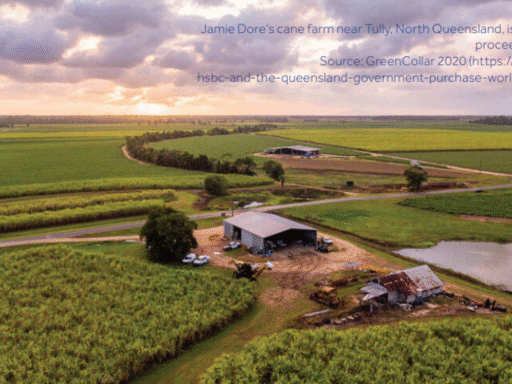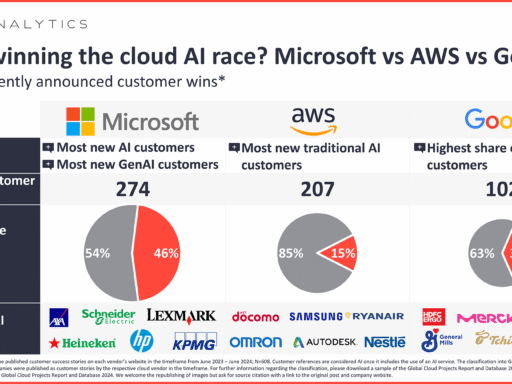Data collection
The data collection made within the COFASP project was extended in ERA-NET Cofund BlueBio through 4 surveys (once a year from 2019 to 2022) and an in-depth web and database search and review. The latter was carried out by database administrators (CNR-IRBIM) on the EU projects’ websites, the websites of research institutes/universities as well as on those of national and international funding agencies.
Surveys consisted of circulating a questionnaire – in .xls file with predefined fields to fill – amongst information producers (i.e., project coordinators, national research funding agencies involved in BlueBio projects); several reminds were sent to increase the response rate. Each Bluebio partner was clearly in charge of collecting its own national projects, asking for its own networks of research institutions and making great effort to directly contact relevant and priority projects. The questionnaire (BlueBio_database_data collection questionnaire.xlsx) is made available through the unrestricted repository at figshare11.
Note that the collection process ultimately depended on the identified key national contacts/information providers and their level of engagement with COFASP (before) and BlueBio (after) network and partners.
Data collection made also use of anonymous users who were able to submit independent records by using the “New project” module of the developed webGIS (Fig. 1). For this purpose, the webGIS and its web-based module for data entry was promoted during several BlueBio project meetings.
Data harmonisation
The harmonisation process involved refining and cross-validating the collected information to allow comparison and analysis. It was long and time consuming.
First, a content cleaning process took place whereby the grammar, spelling and format were checked (e.g., institutions were standardised and traced back to predefined institutional signatures). Then, each entry (both by anonymous web-users and interviewed partners) was cross-validated against all the available data sources (e.g., questionnaires, institutional projects’ database and project’s specific websites) and, if necessary, integrated and edited by administrators before it was stored in the database. This process is hereinafter referred to as data retrieval (Table 1 and Table 2).
For a better characterization of the projects, based on the action fields of the BlueBio project, new fields of information were added such as identification by research category and source of funding.
Four main research categories were considered: Fisheries, Aquaculture, Seafood Processing and Marine Biotechnology. The combination of 2 or more categories was also considered to characterise cross-cutting research projects.
According to the related supporting programmes and instruments of funding, each project was also assigned to one of the following funding sources: National, European, European/National and Other. The former includes those projects that were exclusively funded within national programmes or instruments of funding (e.g., the Italian National Research Programme and Projects of Relevant National Interest), while the second includes EU Framework Programmes for Research and Technological Development/Research and Innovation (FP4 – FP8/HORIZON 2020) and EU funding programmes such as LIFE, COST or INTERREG. ERA-NET schemes and National Programmes supported by European Structural and Investment Funds are instead examples of what was labelled as European/National. Finally, projects falling out of the previous funding sources such as those funded by a consortium of Countries, international organisations, agencies or programmes not relying on EU funds were labelled as Other (e.g., Joint Programming Initiatives and Bilateral/Multilateral Cooperation Agreements).
An additional effort was made to harmonize the programme field. For example, the overarching funding programme was reported for each EU funded projects (e.g., FP4, FP5, Horizon 2020), the national projects were generalized as “National Programme”, while the projects cofounded trough the ERA-NET scheme were included in “International Cooperation”.
Regarding the projects’ budget, when necessary, it was translated into Euro using the exchange rate of the starting year of the project. Similarly, foreign projects’ abstracts were translated into English before they were stored in the database.
Last, to allow a better characterization of the projects and their easier search in the database, each project was associated with keywords taken from a list previously identified by database administrators (Online-only Table 1).
Geographical extension
Projects were geographically allocated based on the marine area(s) where the research was carried out and the countries of the institutions involved. It allowed to highlight eventual differences between the European seas and/or countries.
Countries were directly linked to each institution, while projects were allocated into marine areas following these criteria:
-
if the study area and/or case studies were clearly recognizable the project was associated with specific marine area(s);
-
if the study area was not indicated but the project dealt with field experiments, the marine area of the coordinator country was used;
-
if the study area was not indicated and the project did not deal with field experiments (e.g., laboratory genetic projects), the project was labelled as Not associated with marine areas. It was the case of those projects dealing on Aquaculture, Seafood Processing and Marine Biotechnology that were not specifically carried out at sea.
The marine areas were identified following a hierarchical structure composed by 3 different levels of detail: Area, Subarea and Division. The identification of the Areas and Subareas was based on the Food and Agriculture Organization (FAO) Fishing Areas12: Atlantic Northeast (FAO Area 27), Atlantic Eastern Central (FAO Area 34) and Mediterranean and Black Sea (FAO Area 37). The FAO Fishing Divisions were also considered for the Atlantic Northeast and Atlantic Eastern Central, whereas the FAO-GFCM Geographical subareas (GSAs) were used for the Mediterranean and Black Sea. Overall, the 3 major Marine areas, Atlantic Northeast, Atlantic Eastern Central, Mediterranean and Black Sea were divided into 18 subareas and 75 divisions (Fig. 2, Online-only Table 2).
Construction of the database
Tables 1, 2 summarise the information fields gathered through the collection and harmonisation process. Some were directly collected through questionnaires or by searching and comparing different sources of information such as institutional projects’ databases and project’s specific websites, while others were assigned by database administrators. Overall, 22 fields were associated with each record (project). Coordinator names and emails are stored in the database but not shared for privacy.
Program details (information fields: Programme1 and Programme2) are currently being harmonised by database administrators, and will be soon released in the next version of the data repository.
The relational database was built in PostgreSQL and consists of a collection of tables that store interrelated data (Fig. 3). Each record is associated with a unique ID (e.g., pkid for each project) which allows creating relationships between tables. It was managed and maintained using different database management tools (e.g., pgAdmin).
Data Records
Once subjected to the quality control procedures, the dataset presented in figshare11 (https://doi.org/10.6084/m9.figshare.21507837.v3) is a copy of the database as it was on 28 August 2022. By this date, it consisted of 3,254 “georeferenced” records of national/international projects active in the time period 2003–2019. This dataset will be updated by the end of 2023 in figshare to reflect data additions (projects active in the period 2019‐2022) and updates (i.e., programme1 and programme2).
The repository follows the FAIR principle of Findability, Accessibility, Interoperability and Reusability of data.
Some examples of information that can be drawn by the analysis of the data stored in the released BlueBio database are shown hereafter.
Most of the projects started in the period 2004–2017, and mainly focused on Fishery, Aquaculture and Seafood Processing (Fig. 4). Among the cross-cutting categories instead, Aquaculture & Marine Biotechnology was the most populated (12% of the projects), while all the others appeared poorly represented and accounted at most for 4% of the total (Aquaculture & Fisheries). Even though most of the 2-levels cross-cutting categories have been addressed since 2001–2002, the number of related projects remained rather low except for Aquaculture & Marine Biotechnology which slowly increased over time. The interdisciplinary projects addressing 3- and 4-level categories, instead, generally started later with a discontinuous trend and very low numbers.
Overall, 26 out of the 96 countries involved were EU MS (including the United Kingdom as Brexit entered into force in 2020) and 58 non-EU countries. Norway dealt with the highest number of projects (1,649) followed by Italy, Spain, and the United Kingdom, which however participated in a far lower number of projects ranging from 427 to 467 (Fig. 5). Again, Norway coordinated the highest number of projects (more than 45% of the total universe of the database), followed by Italy (8%) and Germany (6%). On the other hand, Spain, the United Kingdom and France were involved in the highest number of projects as partners (8–9%; Fig. 5). A few countries (e.g., Germany, Poland and Finland) maintained a similar importance in the categorization both by coordinator and involved country, while others were only involved and never coordinated (e.g., Hungary and Lithuania).
The majority of the projects were funded at national level, while 18% by the European Commission (Fig. 6). The projects co-financed by European and National funds and those supported by Other funding sources accounted for 11% and 0.09%, respectively. Excluding projects for which the budget information was not available (948), 34% of the collected projects have a budget greater than 500 k€, 13% lower than 100 k€ and 24% between 100 k€ and 500 k€.
Projects with budgets >500 k€ represented 50% on average of the projects in each research category and around 90% of the total funding, while low budget projects (<100 k€), in general, did not exceed the 2% of the total funds of a research category.
Project’s budgets ranging between 100 and 500 k€ were quite important in almost all research categories exceeding 30% of the total projects, with the exception of Marine Biotechnology, Aquaculture & Fisheries, Aquaculture & Fisheries & Marine Biotechnology & Seafood Processing. However, they never exceeded 10% of the total funding of a research category.
Bringing together information on funding sources and budget categories, data highlights that most of the projects coordinated by Norway had a budget >500 k€ and were funded by national programmes (Fig. 7). The same was in Italy, the United Kingdom, Spain and France but, in this case, most of the projects were funded by European funding programmes. On the contrary, in all countries the majority of projects with a budget less than 500 k€ were national, while the National-European funding programme financed mainly few projects with a budget >500 k€.
Deeper analysis of topics within each research category highlighted research priorities and needs as well as eventual differences among European marine areas and countries. Obviously, outcomes strongly depend on the identification of topics by users. With regards to Aquaculture, for example, Table 3 lists the 16 main topics identified, among which excel Aquaculture development and/or management, Animal welfare and/or health, Animal feed, and Engineering.
However, Animal welfare and/or health – mainly consisting in the development of farming systems to improve productivity and product quality by increasing welfare and lower the risks of diseases in the farmed species – seemed to be the priority almost everywhere in the Atlantic Northeast (FAO Area 27) and in the coastal waters of Morocco (FAO Area 34) (Fig. 8). Other relevant issues in these areas were related to open-sea aquaculture and the evaluation of impacts induced on farmed species by other human activities or environmental stressors (e.g., climate change, ocean acidification, algal toxins). In the remaining areas of the Atlantic Northeast (Iceland Grounds, central and southern Baltic Sea, Bay of Biscay, Portuguese waters) and in the Mediterranean and Black Sea (FAO Area 37), instead, the most addressed topic was Aquaculture development and/or management, which comprises either projects aimed to push the sector’s production by implementing larval rearing for already farmed and new species and projects dealing with the management of aquaculture and its sustainability, including marine spatial planning. Additional relevant topics are Engineering (i.e., technological development of aquaculture systems both at open sea and land), and Animal welfare and/or health, the latter limited to the Black Sea. In contrast, very few projects dealt on the implementation of integrated multitrophic aquaculture and offshore integrated platforms. Also, the assessment of impacts induced by aquaculture on the marine ecosystem did not appear a priority. Fish appeared the most investigated taxonomic group followed by shellfish (molluscs and crustaceans) and algae. A very low number of projects targeted other low trophic organisms, e.g., ascidians, sea cucumbers, jellyfish, krill.


